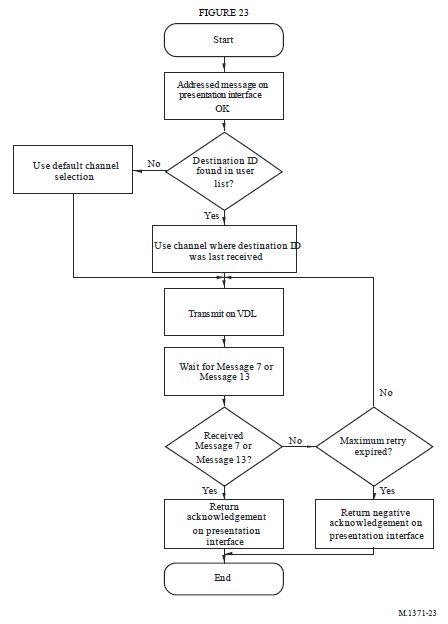The addressed binary message should be variable in length, based on the amount of binary data. The length should vary between 1 and 5 slots. See application identifiers in § 2.1, Annex 5.
TABLE 54
| Parameter | Number of bits | Description | |||
|---|---|---|---|---|---|
| Message ID | 6 | Identifier for Message 6; always 6 | |||
| Repeat indicator | 2 | Used by the repeater to indicate how many times a message has been repeated. Refer to § 4.6.1, Annex 2; 0-3; default = 0; 3 = do not repeat any more | |||
| Source ID | 30 | MMSI number of source station | |||
| Sequence number | 2 | 0-3; refer to § 5.3.1, Annex 2 | |||
| Destination ID | 30 | MMSI number of destination station | |||
| Retransmit flag | 1 | Retransmit flag should be set upon retransmission: 0 = no retransmission = default; 1 = retransmitted | |||
| Spare | 1 | Not used. Should be zero. Reserved for future use | |||
| Binary data | Maximum 936 | Application identifier | 16 bits | Should be as described in § 2.1, Annex 5 | |
| Application data | Maximum 920 bits | Application specific data | |||
| Maximum number of bits | Maximum 1 008 | Occupies up to 3 slots, or up to 5 slots when able to use FATDMA reservations. For Class B “SO” mobile AIS stations the length of the message should not exceed 3 slots For Class B “CS” mobile AIS stations should not transmit; | |||
Table 55 gives the number of binary data bytes (including application ID and application data), so that the whole message fits into a given number of slots. It is recommended that any application minimizes the use of slots by limiting the number of binary data bytes to the numbers given, if possible:
| Number of slots | Maximum binary data bytes |
|---|---|
| 1 | 8 |
| 2 | 36 |
| 3 | 64 |
| 4 | 92 |
| 5 | 117 |
Addressed messages should have a destination user ID. The source station should anticipate an acknowledgement message (Message 7 or Message 13). If an acknowledgement is not received the station excluding Class B “SO” should retry the transmission. The station should wait 4 s before attempting retries. When a transmission is retried, the retransmit flag should be set to retransmitted. The number of retries should be 3, but it could be configurable between 0 and 3 retries by an external application via the presentation interface. When set to a different value by an external application, the number of retries should default to 3 retries after 8 min. The overall result of the data transfer should be forwarded to above layers. The acknowledgement should be between transport layers in two stations.
Each data transfer packet on the presentation interface should have a unique packet identifier consisting of the message type (binary or safety related messages), the source-ID, the destination-ID, and a sequence number.
The sequence number should be assigned in the appropriate presentation interface message which is input to the station.
The destination station should return the same sequence number in its acknowledgement message on the presentation interface.
The source station should not reuse a sequence number until it has been acknowledged or time-out has occurred.
The acknowledgement should be put first in the data transfer queue both on the presentation interface and on the VDL.
These acknowledgements are applicable only to the VDL. Other means must be employed for acknowledging applications.

